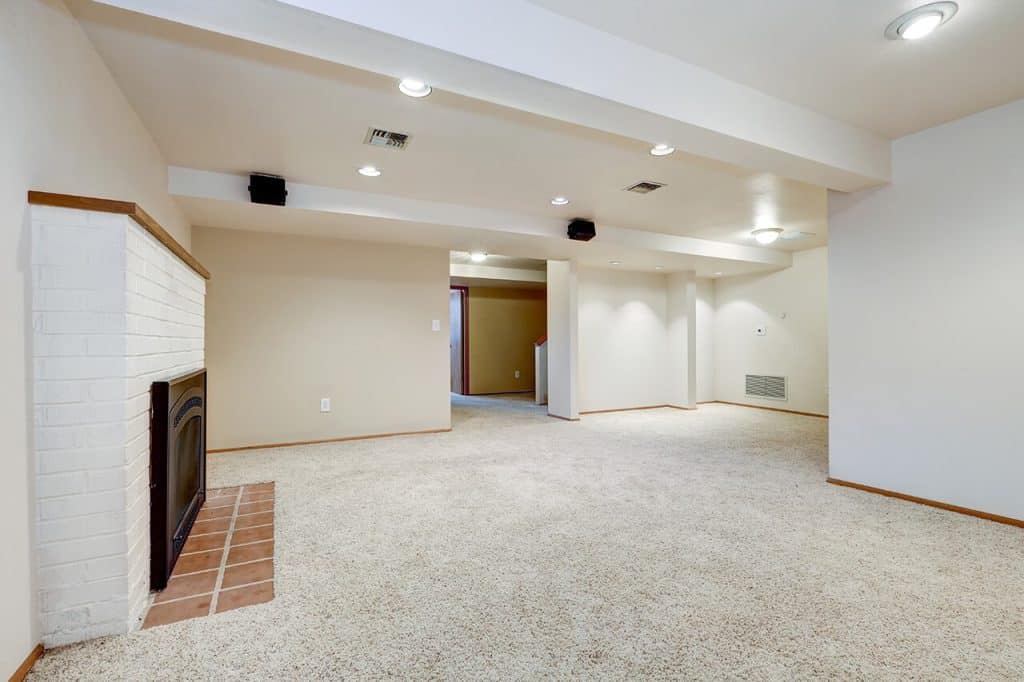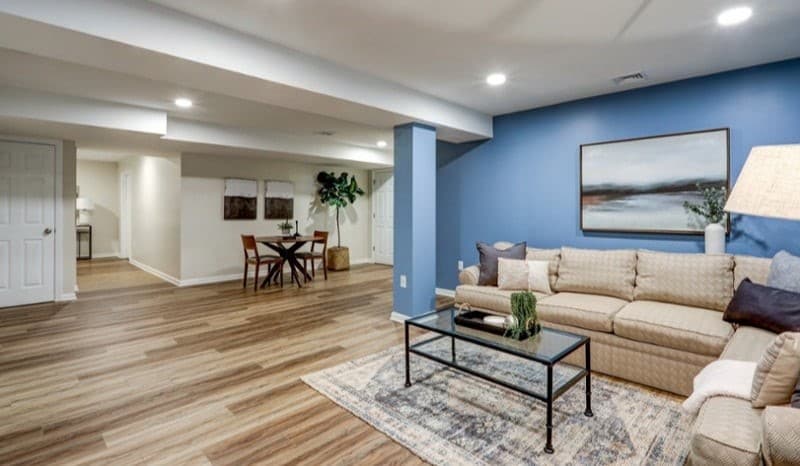Remodeling your basement can be an exciting project that turns unused or underused space into a lively part of your home. The question that crosses most homeowners’ minds is how much a basement remodeling costs. Read on for an overview of various elements that determine your basement renovation costs. By the time you finish reading, you will have the information you need to make budget-based decisions in alignment with your vision.

Major Cost Factors for Finishing a Basement
Basement Size
The size of your basement is one of the big determiners of the cost of your remodel. A larger basement is likely to take more materials, require more labor, and consume a longer time for one to be able to complete the basement. More money shall then be required to complete your remodel.
According to HomeAdvisor, the average cost for basement remodeling is usually calculated per square foot. Remodelers base most averages on size, so a tiny basement will cost much less but possibly cost more per square foot because certain fixed costs could be charged per unit, such as bathroom installations or egress windows.

Basement Type
The kind of basement you own (walk-out, look-out, or completely underground) might influence the complexity and expenses of the project. For example, a walkout basement would need some structural aspects and different waterproofing.

Labor Costs
Since the renovation will touch base in the basement, then this means plumbing and electrical duties will fall part and parcel of the renovation. Most of the work is to be done by you, hence the need to get both a plumber and an electrician to assist you. Some of the work needs to be done by a qualified person, so you will need to get one to help you. Besides, employing a general contractor to be responsible for the project is one issue that, in general, would cost another 10-25% of the project.

Additional Factors Affecting Basement Finishing Cost
Individual Projects
Each component of the basement remodel—from plumbing to electrical work—can significantly impact the total cost.

Sump Pump
That would be a very beneficial aspect of the basement for homeowners in high water table and high rainfall area homes. The pedestal-style pump is an inexpensive and least-powered option, while the submersible-style pump provides more force at a lesser cost but has a shorter life. Installation costs between about $640 and $2,090, based on whether a contractor needs to dig a pit in the concrete floor.

Framing
Should you decide to divide your finished basement into several rooms, engaging a carpenter to construct the new wall frames is necessary. The cost for a carpenter’s services, prior to the addition of drywall and insulation, falls between $7 and $16 per linear foot. Therefore, framing for 100 linear feet will range from $700 to $1,600.

Drywall
Putting the walls with drywall in the basement costs about $2 per square foot. Therefore, the general cost of the walls will likely vary from about $800 on a 400-square-foot area to about $3,000 on a 1,500-square-foot room.

Ceiling joists
The basement ceiling is part of the costs, whether insulation or drywall. The other ceiling alternative, the drop ceiling, hangs below overhead pipes, wires, and ductwork of the basement. It usually ranges from $2 to $6 per square foot, or $800 to $9,000.

Insulation
Enhancing your new basement living space with wall and ceiling insulation boosts both comfort and energy savings. Basic insulation materials, like foam board or fiberglass batting, are budget-friendly, ranging from $1.50 to $2.50 per square foot, though they are prone to water damage. Premium alternatives, such as spray foam, can reach up to $5 per square foot and necessitate expert installation, offering superior efficacy and longevity. Typically, the cost to insulate a basement falls between $1,400 and $6,300.

Painting
After drywall installation, it requires painting. The cost for professional interior painting services averages around $3.50 per square foot, leading to a total expense for painting the whole basement ranging from $1,400 to $9,000, based on the total area to be painted.

Flooring
Flooring expenses vary significantly based on the materials selected. Options like laminate and carpet are more economical, ranging from $3 to $11 per square foot, whereas hardwood floors can go as high as $22 per square foot. For a new basement floor, the anticipated cost ranges from $1,500 to $4,500.

Plumbing Work
The extent of plumbing required for your finished basement hinges on its intended use. In many homes, plumbing lines already extend through the basement, potentially keeping costs down if extensive rerouting isn’t necessary. On the other hand, a full basement bathroom, laundry room, or a new drainage system will include more investment, such as additional piping to be installed. A certified plumber charges usually between the range of $45 up to $200 per hour or anything between $2,500 and $5,000 of total costs.

Egress Windows
For example, if you change your basement into an additional bedroom, an egress window will have to be installed. An emergency exit window can cost from $2650 to $5650. Also, the window must be at least 20 inches wide and 24 inches long to be properly opened as an emergency exit window in line with building standards. If, in any case, your basement is beneath the level of the ground, it calls for digging and supporting a window well for the up to your egress window since it would call for a very huge investment.

Electrical Work
Electrical wiring will be properly put by a licensed electrician. Most electrician services would usually have a basic hourly rate ranging from $50 to $100. Therefore, for a basement of approximately 1,000 square feet, the cost may range from $3,000 to $5,000. These make a total cost, which may vary in accordance with the number and the type of lighting fixtures needed and other electrical devices. Besides, if it needs to have a new electric panel since the load has increased, then the cost has to be even higher.

Furnishings
Transforming a basement into a functional, yet unfurnished, living area is just the beginning. A comprehensive basement renovation includes the addition of furniture, gadgets, and various amenities. Whether you’re embarking on a remodeling endeavor or fully outfitting the basement for the first time, consider personalizing the space with some of these enhancements and items:
Foosball table: $650
Basic seating and tables (including a sofa, loveseat, and end tables): $2,050
Pool table: $2,800
Laundry setup: $3,875
Wet bar (inclusive of plumbing, a sink, and countertops): $8,000
Small kitchen: $15,750
Home cinema system: $17,500

Permits
A basement renovation is a substantial project with structural alterations, one or more building permits are required. The cost of the permits will bear the details of the project, such as necessary plumbing and electrical installations, according to the requirements of local building codes. Generally, the total of permit fees for a project of such nature ranges from $1,160 to $1,350.

Repairs
Building permits typically cover inspection fees, yet discovering any preexisting structural issues necessitates repairs prior to initiating the finishing process. Fixing foundational damage represents a significant financial commitment, with expenses ranging from $2,160 to $7,735, crucial for ensuring your home’s stability and the effectiveness of the newly finished area. Moreover, the presence of hazardous substances like mold or asbestos in your basement requires professional removal, with remediation costs varying between $1,170 and $3,050.

Waterproofing
Waterproofing your basement is vital for ensuring the area is both secure and comfortable, particularly in areas prone to moisture. Basic methods of damp proofing, such as using waterproof paint or vapor barriers, typically range from $3 to $6 per square foot. In contrast, more robust waterproofing techniques, like the installation of French drains or external membranes, can cost between $5 and $10 per square foot. It’s possible that these expenses for labor and materials may overlap with costs for framing and insulation. Therefore, consulting with a professional contractor to determine the most effective approach to waterproof your basement is recommended. Additionally, addressing existing water damage can be costly, ranging from $450 to $13,000, making prevention a critical strategy.

Professional vs. DIY Basement Finishing
While any other aspects of the basement finishing process have to do at the do-it-yourself level, most of the work needs the skill of professionals holding a license. Here are a few insights into how your investment in professional services will pay off in your project.

Professional Basement Remodeling Finishing
Compliance with building codes and safeguarding your home’s value require that all plumbing and electrical tasks be performed by licensed experts. This principle also applies to any work involving the foundation and structure, as well as modifications to the HVAC system. For extensive framing and insulation needs, considering professional help is advisable. Professionals ensure the work is done efficiently and cleanly, armed with the right knowledge about permits and regulations. Additionally, professional installation may be mandatory for certain materials to maintain their warranties.
DIY Basement Finishing
On the flip side, DIY enthusiasts can manage many of the final touches themselves. Tasks like painting, laying down straightforward flooring and trim, tiling, decorating, and furnishing are suitable for DIY projects. However, basement finishing encompasses a wide array of specialized skills, and it’s unlikely a DIYer will possess the requisite tools and expertise for every task. Therefore, it’s important to select DIY projects judiciously. While a professional team might transform an unfinished basement into a completed one in about 45 days, undertaking the project on your own will significantly extend the timeline.
How to Reduce Basement Finishing Costs
To reduce basement finishing costs, start with a detailed plan and a realistic budget. Consider DIY tasks such as painting or installing flooring to save on labor. Reuse materials and shop around for discounts to cut down on expenses. Opt for simpler designs and cost-effective materials, and get multiple quotes for any professional work needed.
For larger projects, consider completing the work in phases. Prioritize proper insulation and waterproofing to prevent future expenses. Lastly, make sure to understand the permit requirements to avoid additional costs later. With careful planning and strategic choices, you can achieve a great basement finish while keeping costs in check.

How to Hire a Professional
If you do hire subcontractors to finish your basement or refinish it, conventional counsel exists that you make sure they do a decent job.
First, verify that the plumbing, electrical, and HVAC contractor trades are licensed and current in your state. This becomes important to reassure that the work would have been done up to standard.
In addition, all the contractors working on your project should have a bond and insurance. In this way, any loss or injury is safeguarded, which may occur while the project is ongoing.
Another key step in the hiring process involves conducting thorough research on each potential contractor.
Moreover, the references will be from past clients of the contractor, and they will firsthand have experienced the work done by that contractor. You can as well check the good customer review sites, such reputation of the entire firm, through platforms like Trustpilot and Google Reviews.
For further clarification of financial details and even competitiveness, get at least three detailed quotes from different contractors.
Finally, you need to be clear on the timeline with all specifics, including the payment schedule and key milestones. All these must be sorted in good time to preempt surprises or delays that may be caused and can be avoided, making the whole process clear and open through the process.

Conclusion
Therefore, an improved basement of the home is an enhancement in its value and living quality; however, careful planning and budgeting are required. Being armed with the knowledge of what is involved in costs will help you make better decisions on how to achieve that dream basement while watching the money.
Basement Finishing FAQ
What are the benefits of basement finishing?
Finishing your basement can increase your home’s value, add living space, and provide a canvas for personal expression.
What are some recommended ways to finish a basement?
Common approaches include adding a family room, extra bedrooms, a home office, or specialized spaces like home theaters or craft rooms.
What is included in a finished basement?
A finished basement typically includes finished walls, ceilings, flooring, electrical work, and often a bathroom or kitchenette.
Is it most cost-effective to finish a basement or add on?
Finishing a basement is often more cost-effective than adding on to a house, as the basic structure is already in place.










